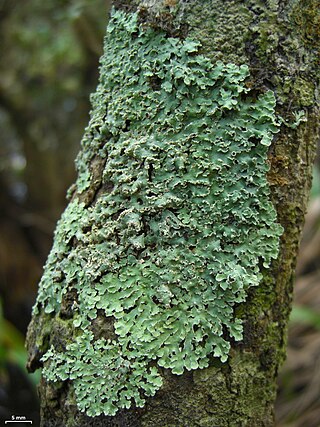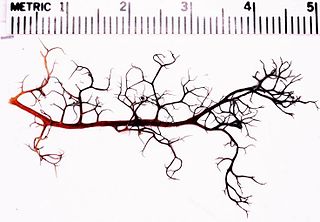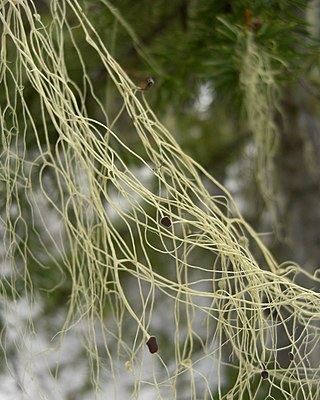
Lichenology is the branch of mycology that studies the lichens, symbiotic organisms made up of an intimate symbiotic association of a microscopic alga with a filamentous fungus. Lichens are chiefly characterized by this symbiosis.

Usnea is a genus of mostly pale grayish-green fruticose lichens that grow like leafless mini-shrubs or tassels anchored on bark or twigs. The genus is in the family Parmeliaceae. It grows all over the world. Members of the genus are commonly called old man's beard, beard lichen, or beard moss.
Irwin M. Brodo is an emeritus scientist at the Canadian Museum of Nature, in Ottawa, Ontario, Canada. He is an authority on the identification and biology of lichens. Irwin Brodo was honored in 1994 with an Acharius Medal presented to him by the International Association for Lichenology.

Physcia is a genus of lichen-forming fungi in the family Physciaceae. The widely distributed genus contains about 80 species. The genus is cosmopolitan, and has been extensively studied in various regions in the past several decades, with significant biodiversity in South America identified as a central diversity hotspot. Physcia species are foliose, lobate lichens that grow with a loose to close appressed habit. Their upper surface is typically whitish, pale greenish, green-grey, or dark grey in colour. The thallus colour remains relatively unchanged when moistened. Physcia lichens typically grow on bark, on wood, or rock, although they have occasionally been recorded dwelling on man-made structures. They thrive in nutrient-rich environments and are expanding rapidly in urban areas of the United Kingdom previously affected by SO2 pollution.

Pseudephebe is a genus of fruticose lichens in the family Parmeliaceae. It contains three species that grow on rocks.

Hypogymnia is a genus of foliose lichens in the family Parmeliaceae. They are commonly known as tube lichens, bone lichens, or pillow lichens. Most species lack rhizines that are otherwise common in members of the Parmeliaceae, and have swollen lobes that are usually hollow. Other common characteristics are relatively small spores and the presence of physodic acid and related lichen products. The lichens usually grow on the bark and wood of coniferous trees.

Nodobryoria is a genus of medium to large, reddish-brown lichens that are hair-like to shrubby in shape and grow on conifer trees. The genus contains three species, distributed in North America and Greenland, which were previously included in the genus Bryoria. Nodobryoria is similar in appearance to Bryoria, but is differentiated because it does not contain the polysaccharide lichenin, and it has a unique cortex composed of interlocking cells that look like pieces of a jigsaw puzzle when viewed under a light microscope.

Gowardia is a genus of medium-sized, greyish hair lichens in the family Parmeliaceae. It is a circumpolar genus, mainly restricted to arctic-alpine habitats in northern Canada, Europe, and Russia.

Bryoria is a genus of lichenized fungi in the family Parmeliaceae. Many members of this genus are known as horsehair lichens. The genus has a widespread distribution, especially in boreal and cool temperate areas.

Alectoria is a genus of fruticose lichens belonging to the family Parmeliaceae.

A foliose lichen is a lichen with flat, leaf-like lobes, which are generally not firmly bonded to the substrate on which it grows. It is one of the three most common growth forms of lichens. It typically has distinct upper and lower surfaces, each of which is usually covered with a cortex; some, however, lack a lower cortex. The photobiont layer lies just below the upper cortex. Where present, the lower cortex is usually dark, but occasionally white. Foliose lichens are attached to their substrate either by hyphae extending from the cortex or medulla, or by root-like structures called rhizines. The latter, which are found only in foliose lichens, come in a variety of shapes, the specifics of which can aid in species identification. Some foliose lichens attach only at a single stout peg called a holdfast, typically located near the lichen's centre. Lichens with this structure are called "umbilicate". In general, medium to large epiphytic foliose lichens are moderately sensitive to air pollution, while smaller or ground-dwelling foliose lichens are more tolerant. The term "foliose" derives from the Latin word foliosus, meaning "leafy".

Lichens are symbiotic organisms made up of multiple species: a fungus, one or more photobionts and sometimes a yeast. They are regularly grouped by their external appearance – a characteristic known as their growth form. This form, which is based on the appearance of vegetative part of the lichen, varies depending on the species and the environmental conditions it faces. Those who study lichens (lichenologists) have described a dozen of these forms: areolate, byssoid, calicioid, cladoniform, crustose, filamentous, foliose, fruticose, gelatinous, leprose, placoidioid and squamulose. Traditionally, crustose (flat), foliose (leafy) and fruticose (shrubby) are considered to be the three main forms. In addition to these more formalised, traditional growth types, there are a handful of informal types named for their resemblance to the lichens of specific genera. These include alectorioid, catapyrenioid, cetrarioid, hypogymnioid, parmelioid and usneoid.

Hypogymnia imshaugii, commonly known as the forked tube lichen, is a common species of foliose lichen in the family Parmeliaceae. It was formally described as a new species by Norwegian botanist Hildur Krog in 1968. It has a grey to gray-green thallus with slender lobes measuring up to 2 mm wide that are branched dichotomously at regular intervals. It has cup- to disc-shaped apothecia that are constricted at the base. The lichen grows on conifer branches, preferring inland habitats that are moderately dry.

Melanohalea subelegantula is a species of lichen in the family Parmeliaceae. It is found in North America, where it grows on bark and wood. The lichen was first formally described as Parmelia subelegantula by Ted Esslinger in 1977. A year later he transferred it to the segregate genus Melanelia. In 2004, it was moved to the newly circumscribed genus Melanohalea. Named for its resemblance to Melanohalea elegantula, it can be distinguished from that species by its slightly flattened, but not hollow, isidia.

Melanohalea elegantula, commonly known as the elegant camouflage lichen, is a species of lichen in the family Parmeliaceae. It was first described by Alexander Zahlbruckner in 1894 as Parmelia aspidota var. elegantula. Hungarian lichenologist Ödön Szatala promoted it to full species status, as Parmelia elegantula, in 1930. Ted Esslinger transferred it to the genus Melanelia in 1978. Finally, it was assigned to the newly circumscribed genus Melanohalea in 2004.

Calicium trabinellum, commonly known as the yellow-collar stubble lichen, is a widespread species of pin lichen in the family Caliciaceae. It was first described by Swedish lichenologist Erik Acharius in 1803 as Calicium xylonellum ß trabinellum. He made the new combination Calicium trabinellum in a later chapter of the same publication.

Ochrolechia africana, commonly known as the frosty saucer lichen, is a species of crustose and corticolous (bark-dwelling) lichen in the family Ochrolechiaceae. It is a widely distributed species, found in tropical and subtropical areas of southern Africa, Asia, Australia, North America, and South America. The lichen is characterized by the presence of a white "frosty" or powdery apothecia.

Gowardia nigricans, commonly known as the gray hair lichen or gray witch's hair, is a species of fruticose lichen in the family Parmeliaceae.

Lobaria anomala, commonly known as the netted specklebelly, is a species of foliose lichen in the family Peltigeraceae. It is found in coastal western North America, where it grows on trees in humid environments. The lichen was first described as a new species in 1987 as a species of Pseudocyphellaria, though it had been mentioned in scientific papers before.

Sulcaria spiralifera is a species of fruticose lichen in the family Parmeliaceae. It is found in the northwestern United States, where it grows as an epiphyte, hanging from a variety of tree species in open or shaded maritime forests.



















